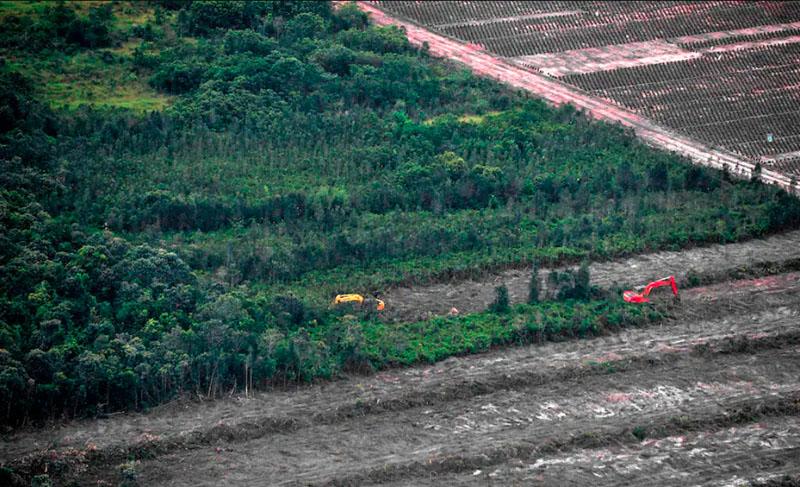An enormous missing contribution to global warming may have been right under our feet
By: Chris Mooney (The Washington Post)


Carbon, carbon, everywhere. Too bad we can't eat silicon sand.
The recent media attention given to the impact of farming on climate change obviously serves some sort of political agenda. The United Nations Climate Change Conference (COP26) will convene in Glasgow this coming November. So, talking points must be prepared.
Obviously these newly discovered sources of carbon emissions from disrupted soil creates doubts and potential disagreement about the validity of net-zero carbon accounting that relies upon carbon sinks. Farming for palm oil can't be considered a carbon sink since disrupting land for farming releases CO2. The science is being used to feed politics attempting to eliminate farming from net-zero accounting.
Don't ignore the money interests involved in raising doubts about net-zero carbon accounting. Financial interests see carbon credits as another bitcoin bonanza. And those selling electrical technology want to expand the market. Money really is playing a supersized role behind the gaudy facade of international harmony. COP26 will involve as much competition as cooperation.

Long before the era of fossil fuels, humans may have triggered a massive but mysterious “carbon bomb” lurking beneath the Earth’s surface, a new scientific study suggests. If the finding is correct, it would mean that we have been neglecting a major human contribution to global warming — one whose legacy continues.
The researchers, from France’s Laboratory of Climate and Environmental Sciences and several other institutions across the globe, suggest that beginning well before the industrial era, the mass conversion of carbon-rich peatlands for agriculture could have added over 250 billion tons of carbon dioxide to the atmosphere. That’s the equivalent of more than seven years of current emissions from the burning of fossil fuels for energy.
“Globally [peatlands] are only 3 percent of the land surface but store about 30 percent of the global soil carbon,” said Chunjing Qiu, a researcher at the laboratory, a joint institution supported by French government research bodies and the Versailles Saint-Quentin University, and the first author of the study published Friday in the journal Science Advances.
The new finding of an “ignored historical land use emission” suggests that even now, we lack a complete understanding of how the Earth’s land surfaces are driving and modulating the warming of the planet. That’s troubling, since the use of land to trap and contain greenhouse gases is set to play a critical role in the Paris climate agreement.
Scientists have long worried about the potential for massive amounts of carbon being released by northern permafrost, where ancient plant remains lie in a kind of suspended animation beneath the surface. But the peat threat is very similar; in fact, peatlands overlap considerably with permafrost regions.
Peatlands are a particular type of wetland, one in which dead plant matter does not fully decay due to the watery conditions, and thus accumulates. In its normal state, peat slowly pulls carbon out of the atmosphere — unless you disturb it.
If a peatland is drained — as has occurred for many centuries to promote agriculture, especially the planting of crops — the ancient plant matter begins to decompose, and the carbon it contains joins with oxygen from the atmosphere. It is then emitted as carbon dioxide, the principal greenhouse warming gas.
Carbon dioxide can stay in the atmosphere for hundreds or even 1,000 years, meaning that peatland conversions from long ago, even before we began large-scale burning of fossil fuels, can still be affecting the planet.
“It is almost 10 percent of the carbon that humans have emitted by burning fossil fuels since 1850,” said Philippe Ciais, a co-author of the study and a researcher with the Laboratory of Climate and Environmental Sciences.
What’s difficult is knowing when and where these historical peatland conversions occurred. For example, when a bog was converted to farmland or someone dug a drainage ditch, it’s not necessarily the case that anyone recorded it.
Nonetheless, we know that humans have drained large areas of wetlands, and they started early. One example from Minnesota: Between 1900 and 1915, 9 million acres of wetlands had been drained by humans for agricultural and other purposes. Were any of these peatlands? It’s hard to say.
“If a land has been converted for many years and the carbon lost, then by definition this is not a peatland any more,” Qiu said. “So people cannot say where is peatland and where is not peatland from current observations.”
To try to get around the problem of missing historical records, the new study simulates the Northern Hemisphere (outside of the tropics) over thousands of years to determine where peat would have likely developed. Over time, the computer model will begin to include growing agricultural activities. It can then be used to analyze different scenarios for how frequently such developments may have occurred on peatland.
In a middle-of-the-road scenario, where humans would have regularly grown crops on peatlands, the study finds that some 70 billion tons of carbon (over 250 billion tons when converted to carbon dioxide) would have been lost from the soil.
Importantly, the analysis does not cover all the peatlands across the globe: It only considers Northern Hemisphere peatlands from the year 850 CE onward. Massive losses of tropical peat are even now occurring in countries like Indonesia and Malaysia, for instance, so global losses will be higher.
Scientists told The Washington Post that historic peatland emissions are certainly real, although we don’t know their true magnitude.
“Peatland carbon losses resulting from historical land use change is likely to have made a big contribution to global warming in the past,” said Sofie Sjögersten, an expert on peatlands at the University of Nottingham in the United Kingdom who read the new study.
Still, Sjögersten isn’t sure which historical peatland scenario is right, and thinks the emissions could have been lower than suggested by the study if humans only turned to draining peat once all other good land had been used. (The study includes a scenario like this, which downscales the emissions considerably.)
The study is “a broad modeling approach with many assumptions, which can all be individually questioned and debated,” added Hans Joosten, who leads a peat research group at the University of Greifswald in Germany. “But the overall message that remains is that drainage of only a small part turns the entire northern peatland resource into a net carbon source. Though peatlands indeed are carbon sinks in their pristine state, they should also be seen as carbon bombs, which explode whenever they are damaged. Keep them wet!”
The new study is a good “first estimate,” added Simon Lewis, an expert on peat and wetlands at the University of Leeds in the U.K. “What is needed now is for other groups of scientists with different models of peatlands development to tackle the same question to assess if they find a similarly large historical carbon source.”
If the numbers from the current study are correct, it would require reassessing much of what we believe occurred with the planet’s carbon cycle. All that peat carbon must have gone somewhere, and we already know how much carbon is in the atmosphere.
This suggests some of the peat carbon must instead have gone back into the land as plants grew, according to the researchers. Which, in turn, might mean more of a buffer exists against climate change than previously believed.
“It’s bad news, because we find a new source in the budget, and it’s a big one,” Ciais said. “If you want the good news, or the implication, the rest of the vegetation has in fact reabsorbed more carbon than we thought.”
Lewis, however, said he thinks there is another possible explanation. If humans cut into a lot of peat historically, then another way to balance the carbon budget is to assume they did less deforesting, a process that also results in emissions. Ciais agreed that’s also a possibility.
Either way, the new work underscores that major gaps remain in how much we know about the human contribution to climate change, even as we are trying to halt it. With poor understanding about peat locations, and poor reporting about land conversion, experts say, many countries can’t fully account for peat emissions even now. That could raise questions about what has been happening in their land-use sector, especially in a key United Nations category called “managed lands.”
“Countries are responsible for all the emissions on their managed land. And here it is managed land,” Ciais said of peatlands. “They don’t always necessarily report this number.”






BTW, the implication of these science based stories concerning soil emissions suggests that planting trees won't solve climate change. Simply digging a hole will release carbon.
And now that farming plant crops has been identified as a major contributor to climate change there is much less justification for giving up beef. The climate alarmists need to adjust their talking points.